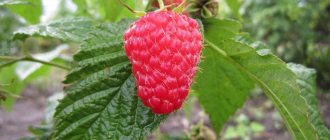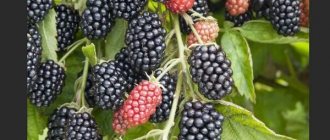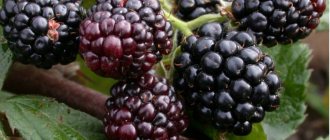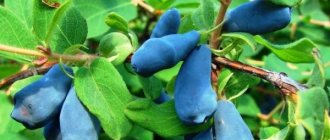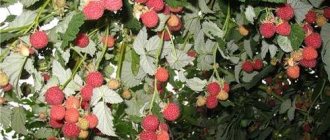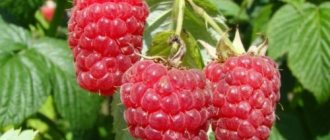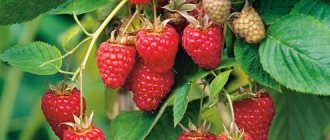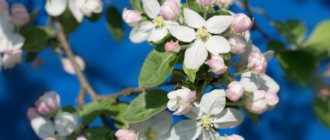Description and characteristics
The plant is remontant and can bear fruit twice a year. Raspberries form their first harvest in early July; the number of berries during the first fruiting is very small. The main (late) harvest of Firebird berries ripens in August.
Firebird bushes are tall, slightly spreading, the length of an individual stem reaches 200 cm. The peculiarity of this productive variety is that each stem is covered with soft, but not very sharp thorns. The leaves of the variety are green, slightly corrugated, the diameter of the leaf plate is 8–12 cm.
The berries are large, conical, easily removed from the bush, which helps maintain the integrity of the fruit during harvesting. The fruits are dark red in color, very large in size, up to 15–20 mm long, the weight of an individual berry can vary from 4 to 6 g. The berries are juicy, soft, and have a sweet and sour taste.
Reviews
Victor.
The Firebird really made me happy. This is real. It rains constantly here. The Orange Miracle has begun to rot, and the Firebird stands there as if nothing had happened. It's all clean, not rotten, the taste is perfect.
Elena.
Hello. Even after rains, the berries remain incredibly tasty. The bushes are green and spreading. I prune in the fall. I don’t like the summer harvest, because it’s small and the taste isn’t the same. Although everyone says that summer and autumn raspberries are the same.
Advantages and disadvantages
Varietal berry plants have significant advantages over wild-growing representatives of the crop - they have better taste and larger fruits. But each variety also has its own disadvantages.
- Benefits of Firebird raspberries:
- large berries;
- harmonious taste of fruits;
- not sharp thorns;
- high productivity;
- dry separation of the berry from the drupe.
- Disadvantages of Firebird raspberries:
- the need to garter tall stems;
- poor transportability of soft, juicy fruits;
- poor winter hardiness.
Important! All chemical treatments of raspberries must be carried out by the gardener in compliance with the proportions specified in the instructions for the preparations. When working with chemicals, a person must be protected by special clothing and a mask that protects the respiratory system.
Drought resistance, frost resistance
Firebird is intended for cultivation in regions with a warm temperate climate, as it has poor winter hardiness. In the northern regions, the variety can only be grown under dense winter cover or in greenhouses.
Like any other varietal raspberry, the Firebird variety has a branched root system that extends under the soil at a depth of 10–12 cm. The shallow location of the roots contributes to their rapid drying, therefore, in order for the raspberries to bear fruit, the soil under the bushes must be kept moist . Each adult bush uses at least a bucket of water when watering. The frequency of summer watering is once a week. If you mulch the soil in a raspberry garden, you can water the berry garden much less frequently (once or twice a month). You can mulch the soil with straw, grass clippings, and sawdust.
Video: Raspberries of the Firebird variety
Productivity and fruiting
The yield of an adult healthy raspberry bush of the Firebird variety per season is 1.8–2 kg. Experienced gardeners, wanting to increase the yield of this variety, transfer the plants to one-time fruiting mode. To do this, the above-ground part of the bush after August fruiting is mowed down close to the ground . Since pruned remontant raspberries will bear fruit on young shoots next year, fruiting will be immediate (in August), but abundant.
Description of raspberry Firebird
Since childhood, we have been familiar with the taste of tea with raspberry jam. It was a surefire remedy for colds - vitamin C and aspirin in its composition perfectly complemented pharmacy medications. Many schoolchildren know that temperature is not only an opportunity to skip school, it is also mother’s care, expressed by the tart raspberry smell.
Raspberries are grown almost everywhere - even in risky farming areas, gardeners get a harvest of red berries. Selection work was carried out during the USSR and continues now. The result of many years of work by 2 researchers I.V. Kazakov and S.N. Evdokimenko became remontant varieties that allow harvesting several times a season. One of them is the Firebird.
Landing Features
Raspberries can be planted in ditches or deep planting holes filled with fertile soil and humus. Plants can be arranged in single rows or in planting strips. Sometimes gardeners choose planting using the square-cluster method or group planting.
Also find out why raspberry leaves turn yellow.
When using the strip method, bushes are planted in one or several rows at a distance of 1.5 to 2 m between them. This is the minimum range to prevent transmission of infection between strips and provide adequate ventilation and lighting to plants. When planting, a gap of at least 40–50 cm is left between individual seedlings so that the raspberries are not too dense and each plant can receive enough sunlight and space to grow.
When using the square-cluster method, the prepared area of the raspberry tree is divided into squares with a side of approximately 1.5 m. The soil in the marked areas of the future raspberry tree is pre-treated and fertilized . A distance of 1.5 m is also maintained between the squares. Seedlings are planted in the corners of each berry plot; in subsequent years, the bushes grow and fill the area of the raspberry patch.
Care
In order for a raspberry plantation to bear fruit constantly and abundantly, the soil in the raspberry garden must be kept clean from weeds. To do this, carry out regular weeding or fill the space between the bushes with biological mulch (sawdust, hay, straw). Mulching will help solve the problem of weed infestation and prevent moisture from evaporating from the soil.
It is necessary to regularly water and treat plants against diseases and pests. To do this, the above-ground part of the raspberry tree is treated with chemicals, and insecticides are also applied (simultaneously with watering) to the soil. For irrigation, it is convenient to use a drip system, which is laid out between two longitudinal rows of the crop.
Harvesting and storage
Raspberries are harvested more than once during the ripening period, since the berries ripen in several stages. Fruits that have acquired the characteristic color and size of the variety are considered ripe. It is recommended to collect raspberries in a small container with a volume not exceeding 0.5 liters. In such a container, all berries will remain intact and not wrinkled during storage and transportation. The fruits of this crop spoil quickly and therefore have a very short shelf life. Within two days after harvesting from the bush, the berries will begin to deteriorate.
Raspberries are suitable for making preserves, jams, confitures and other preparations. They can also be frozen for the winter, but the fruits do not lose their taste.
Preparing for winter
In areas where winters are cold and frosty, the Firebird must be prepared for sub-zero temperatures so that the crop survives the cold period without loss. When grown with an overwintering above-ground part, the raspberry branches bend towards the ground and are fixed with large metal pins . The soil in the raspberry field is also insulated, since the roots of this crop lie shallow.
An additional layer of mulch is placed on top of the soil; this can be straw, hay or spruce branches. After some time, in winter, after heavy snowfall, the branches pinned to the ground are insulated with an additional layer of snow. Insulation is removed from the raspberry tree in the spring, at the end of March, before the buds swell.
In the south, raspberries are not insulated for the winter, since there are no severe frosts in this region, and there are also no heavy snowfalls that threaten damage to the above-ground part of the berry garden.
Did you know? There are dozens of raspberry varieties that have absolutely no thorns and have a smooth, even stem (Stoleshnik, Pride of Russia, Beauty of Russia, Maroseyka, Taganka). Such varieties are the result of painstaking selection work and, as a rule, are distinguished by very large berries.
History of the variety
The Firebird was created by Russian scientist I.V. Kazakov. Selection work was carried out in the Kokinsky strong point, located in the Bryansk region. In 2008, the variety was registered in the State Register. The remontant raspberry Firebird is recommended for cultivation in all regions of the Russian Federation.
Remontant raspberry Firebird
Note! Gardeners note that the crop grows best in the Central and Central Black Earth regions. Raspberries are grown in private gardens and large farms.
Reproduction methods
There are several ways to propagate varietal raspberries without losing valuable parental qualities. Not all methods are created equal, but a gardener can choose whichever method suits him best. Propagation by root cuttings is considered the most productive in terms of the final yield of seedlings.
Reproduction by maternal roots:
- To do this, in the fall, the roots of the mother bushes are dug out of the ground. The most suitable time for carrying out such work is the beginning of October or the end of September. The above-ground part of the bush removed from the soil is cut off, and the roots are placed in a box with a suitable moisture- and breathable substrate. The thickness of the roots should be at least 3 mm, and their length should be about 20 cm.
- Coarse river sand or sphagnum moss can be used as a substrate. Place a layer of substrate in a shallow wooden box, moisten it with a spray bottle, and then spread the raspberry roots on it in an even layer. Another layer of substrate is placed on top of the roots, which is well moistened.
- The mother plant with roots is transferred to the basement or other room, where during the winter the temperature will be low above zero (+8 ... + 13 ° C). If a gardener expects mass propagation of a given raspberry variety and there are a lot of roots, wooden queen boxes can be stacked on top of each other in stacks of 5 pieces.
- Approximately 40–45 days before the expected date of planting raspberry seedlings in a school, wooden queen boxes are brought into a warm (+20…+23°C), well-lit room. After this, the substrate in which the roots are located must be well moistened with warm water. Boxes with roots are arranged in one layer.
- Heat and light help awaken the buds that are found in abundance on raspberry roots. They swell and begin to grow in the substrate. After some time, the seedlings make their way to the surface of the substrate. Every 2-3 days the substrate needs plenty of moisture. From each mother plant, up to 200 specimens of varietal plants can be obtained in several stages. The cuttings are disconnected from the mother rhizome as soon as they reach a height of 10–15 cm and they have their own root system.
- The school where the cuttings will be transplanted from the mother boxes is located in a place where there is constant partial shade during daylight hours. This location will not allow fragile cuttings to suffer from sunlight. After planting in the spring, the grown raspberry bushes are transplanted to a permanent place in the fall or spring of next year. Such material is considered virus-free and does not carry diseases of the parent plant.
Raspberry bushes can also be propagated using nettles. Such propagation begins in the spring, usually at the end of May, when underground root buds awaken around old raspberry bushes and form young bushes above the ground. These bushes are called “nettle” because of their external similarity to young nettle bushes. Such seedlings have a lush root system and are usually absolutely healthy, that is, they do not have viral and bacterial diseases inherent in the old parent bush.
Agricultural technology
Growing remontant raspberries of the Firebird variety is characterized by certain features that should be taken into account to obtain high returns.
Selecting a site for planting
The timing of planting Firebird raspberries depends on local climatic conditions:
- in the southern regions, autumn plantings are preferable;
- In colder regions, raspberry bushes will take root better in the spring, but they should be planted only after the end of the night frosts.
The site for planting bushes is selected taking into account certain parameters:
- it must be protected from the winds;
- sufficient illumination of the bushes is important;
- Firebird raspberries love fertile soils rich in organic compounds;
- groundwater should not rise above 1.5 m;
- if the soil is highly acidic, it is limed during digging;
- the territory of the site allocated for the raspberry garden must be thoroughly cleared of weeds, especially the rhizomes must be removed;
- When planting Firebird raspberries in spring, the site must be prepared in the fall - add organic and mineral fertilizers to the holes and sprinkle with soil.
Planting options
Repairing Firebird raspberries can be planted in different ways:
- with the bush method, a gap of up to 1.5 m is left between seedlings, and the row spacing should be at least 2.5 m;
- if planting is carried out using the trench method, then about 0.5 m is left between the bushes with the expectation that each seedling will produce 5-6 shoots;
- To avoid shading of the bushes, you need to arrange the rows of raspberries from north to south.
Landing
Before planting, Firebird raspberry seedlings are stored in a cool place at a temperature of 0 to +2 degrees so that the shoots do not begin to sprout. During transportation, their roots are kept in a clay mash to prevent them from drying out. Half an hour before planting, the roots of the seedlings are placed in water so that they are sufficiently saturated with water. When planting, seedlings are buried to the root collar.
Immediately after planting the Firebird raspberry, the following work must be carried out:
- trimming the above-ground part to 30 cm;
- watering seedlings - the norm is half a bucket for each bush;
- mulching the soil around raspberry seedlings - peat, straw, compost can be used as mulch; its layer should be at least 10 cm.
During autumn work, the mulch is dug up and embedded in the beds, becoming an additional feeding for the seedlings.
Houseplant Tradescantia: home care, photos and beneficial properties
Trimming
Annual pruning of Firebird raspberries is mandatory - in the fall, two-year-old shoots are mowed down, leaving no stumps. Therefore, there is no need to cover raspberry bushes for the winter. When pruning in spring, diseased or damaged branches and weak shoots are removed. If the tops of the shoots are frozen, they need to be cut back to healthy buds. Raspberry fruits will be larger if you lightly trim the tops of the shoots. In cold regions, you can speed up the ripening time of the Firebird raspberry variety by covering the soil around its seedlings in spring. Using this technique, you can get a harvest of fragrant berries as early as July.
Annual raspberry shoots in the fall, before the onset of frost, bend to the ground, and the fallen snow cover will reliably preserve them until spring.
Garter bushes
The tall shoots of the Firebird raspberry curl and intertwine heavily, making them difficult to care for, so they definitely need support. It is desirable that it be high enough - the shoots should not exceed the height of the support by more than 20 cm. Otherwise, they will break under gusts of wind. 2-3 rows of wire are stretched between the supports with an interval of 15-20 cm, to which raspberry shoots are tied. The lowest row is installed at a height of about half a meter from the surface of the earth.
Top dressing
In early spring, when the snow melts, remontant Firebird raspberries need to be fertilized with nitrogen compounds, for example, urea. Nitrogen will give the plant the opportunity for rapid growth and development. Further, during the formation of ovaries, the bushes are fed with mineral salts.
Diseases and pests
Raspberries, like any other plant crop, are periodically subject to pest invasions or outbreaks of diseases of various types.
Did you know? Raspberries are used to prepare all kinds of alcoholic drinks: liqueurs, wines, tinctures and even beer.
Major diseases of the culture
Raspberry mosaic is a viral disease that appears in May. Small, approximately 2 mm, yellowish or yellow-brown spots with an irregular contour appear on the leaves. The spots spread quite quickly and occupy the entire surface of the leaf. The change in leaf color is accompanied by severe deformation of the leaf plates. The affected bush does not develop normally, as a result of which the quality of the berries deteriorates. The bushes no longer grow; they can be seen from afar due to the specific color of the leaves. The virus is transmitted by planting material, aphids or other insects.
Prevention and control measures:
- Monitoring raspberry plantations to identify infected bushes.
- Removing diseased plants from raspberries and destroying them using fire.
- Using insecticides to control aphid populations.
Bacterial canker is a bacterial disease that causes growths to develop on the roots and at the base of the stem, initially whitish, soft, and pea-sized, gradually enlarging and becoming brown and woody. The bacterium can survive in soil for many years and is spread through water, dust, and garden tools.
The optimal conditions for the occurrence and development of growths are temperature +22…+30°C and humidity 80%. This disease is promoted by moist and dense soils, excess nitrogen fertilizers, nematodes, etc. Full lighting has an inhibitory effect on the development of the disease.
We advise you to read more about the main diseases and pests of raspberries.
Prevention and control measures:
- Placement of nurseries in sunny places.
- Using healthy planting material.
- Disinfection of tools and equipment.
- Removal of affected bushes with roots and application of soil treatment at the site of removal with copper sulfate.
- Treatment of the roots of planting material in a 1% solution of copper sulfate or with the preparation “Topaz 100 EC 0.025%”.
- Treating the soil during planting with copper-based preparations.
Anthracnose is a fungal disease that appears on shoots in the form of small oval red-violet spots. The disease develops, the spots become gray and whitish, and the tissues rot. Small, purple spots appear on the leaves, which gradually turn gray, and the fruits are deformed and rotting. Fungal spores reach plants from the soil surface, where they overwinter on plant debris. In case of severe infection, the plant dies.
